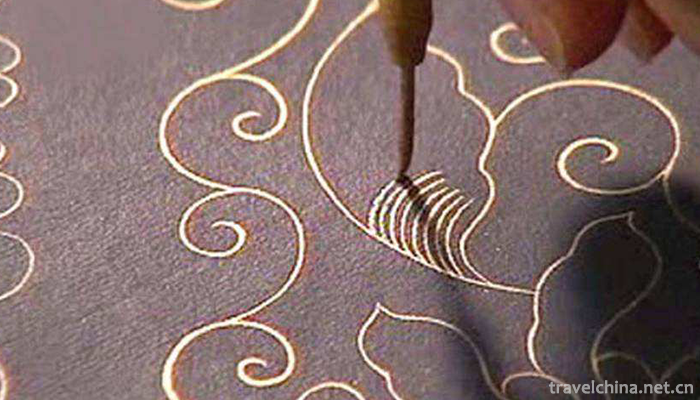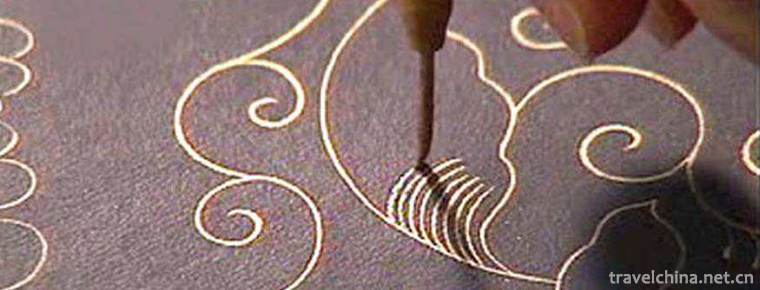Paper Paper Paper Processing Techniques
Paper Paper Paper Processing Techniques
Traditional processing paper is to make raw paper into processing paper by dyeing, sizing, powder filling, waxing, mounting, spraying gold, leveling, watermarking, painting and other processes, in order to be more suitable for writing, printing or calligraphy, painting needs, increase artistry and ornamental, and improve cultural connotation. Traditional paper processing technology products mainly include hand-painted gold powder wax pad, gold and silver printing pad, clay gold pad, wooden board Color Watermarking pad, silk pad, jacquard flower pad and so on.
On June 7, 2008, the paper processing technology was approved by the State Council and listed in the second batch of national intangible cultural heritage list.
Historical Origin
Traditional paper-processing technology is an inseparable part of the history of China's paper-making development. It has an extremely important position in ancient times, and also has a certain position in the history of world paper-making development. Even in modern and contemporary times, it is still an important carrier of calligraphy and painting, undertaking the glorious mission of promoting Chinese culture.
Traditional processing paper is to make raw paper into processing paper by dyeing, sizing, powder filling, waxing, mounting, spraying gold, leveling, watermarking, painting and other processes, in order to be more suitable for writing, printing or calligraphy, painting needs, increase artistry and ornamental, and improve cultural connotation. Traditional paper processing technology products mainly include hand-painted gold powder wax pad, gold and silver printing pad, clay gold pad, wooden board Color Watermarking pad, silk pad, jacquard flower pad and so on.
Chaohu Longyingxuan has devoted itself to the research and production of restorative paperwork which has been lost for many years and is still of practical value today. In 1999, the hand-painted gold powder wax pad, a traditional paper product lost for many years, was successfully restored to production. Rong Baozhai appraised the hand-painted gold powder wax note: "... With fine workmanship and exquisite materials, its manufacturing technology has been innovated on the basis of tradition, and it is the best of the same kind of products at present. In 2002, its production technology was included in the Ninth Five-Year Plan of the Chinese Academy of Sciences, Complete Works of Traditional Chinese Crafts and Paper Making and Printing. In 2000, Chaohu Longyingxuan established a cooperative relationship with the Department of Science and Technology History and Archaeology of China University of Science and Technology. Through cooperation with the relevant research groups of the Department, he successfully copied the Ming Dynasty gold and silver printing pad and co-published the paper "Gold and silver printing pad" in "China Printing". CCTV's 10 columns "Approaching Science" recorded and interviewed the processing process, and its production process was also included in the book "Paper Making and Printing" edited by the Chinese Academy of Sciences.
Hefei, an ancient city with a history of more than two thousand years, has profound cultural connotations. The intangible cultural heritage is a reflection of the cultural trajectory of the work and life of the local people, which is handed down from generation to generation and accumulated over the years.
Since the second half of 2005, Hefei City has carried out the "non-heritage" census work, took the lead in establishing the "non-heritage" four-level directory in the province, and established and improved a relatively complete intangible cultural heritage resources and the information archives of the "non-heritage" project successors.
Yang Chen, curator of Hefei Municipal Culture Museum, told Jianghuai Morning Post and Jianghuai Net that up to now, 513 items of intangible cultural heritage have been surveyed in Hefei, involving 15 categories of folk literature (oral literature), folk art, folk music, folk dance, handicraft and consumption customs.
It is worth mentioning that "Luju Opera", "Ocean Snake Lamp", "Chaohu Folk Song" and "Paper Paper Paper Processing Techniques" have been included in the national list of protection projects. Fifteen non-legacy items such as "Huo Bi Painting" were selected as provincial directory protection projects, and 64 items such as "Xie Donkey" were selected as municipal directory protection projects.
A few days ago, the Provincial Department of Culture announced the second batch of intangible cultural heritage base in Anhui Province. Chaohu City Longyingxuan Stationery Supplies Factory declared that the paper processing skills were successfully selected, becoming the first provincial intangible cultural heritage transmission base in Chaohu City.
Chaohu City takes the inheritance and development of national intangible cultural heritage Chaohu folk songs as its starting point, strengthens policy support, increases capital investment, and strives to strengthen the protection of intangible cultural heritage throughout the city, and achieves fruitful results. Up to now, 75 items of intangible cultural heritage have been selected into the list of national, provincial and Hefei intangible cultural heritage. The Siji Folk Song Association of Hefei has been approved as the "first batch of intangible cultural heritage base in Hefei City". The Suwan Town Folk Song Association is actively striving to create provincial intangible cultural heritage base.
Inheritance Significance
In 2008, the paper processing techniques represented by wax pads entered the second batch of national intangible cultural heritage lists. Paper paper processing technology is the processing technology of Xuan paper for calligraphy and painting. In 1989, Liu Xihong, a Chaohu laker, and Shen Boquan, Bailing Xuan, Jingxian County, jointly established the Hanyuntang Craft Factory in Hefei, which is engaged in paper paper processing and production. In the 1990s, Liu Jing, the son of Liu Xihong, successfully restored the lost "hand-painted gold powder wax pad" processing skills. In 1999, Liu Jing, in cooperation with the Chinese Academy of Sciences and the Chinese University of Science and Technology, jointly restored the Ming Dynasty's "gold and silver printing pad" technique. Subsequently, the traditional paper processing techniques such as clay gold, cinnabar, silk, quicksand and portrait pads were successively restored and developed. It is said that a square meter of wax paper is worth tens of thousands of yuan.
Hefei has four national intangible cultural heritages, including Baogong Story, Liu Mingchuan Story, Firebrush Painting, Hulu Pyramid, Wushan Iron Character, Potassium Alum, Throwhead Lion, Luzhou Drum, Menge, Luzhou Wood Carving, Luzhou Wu Ship Model, Sanhe Feather Fan, Paper-tied Craft, Zipengshan Temple Fair and Wushan Temple Fair. In addition, Hefei has assessed nearly 80 municipal intangible cultural heritage projects and conducted 513 field surveys of the city's intangible cultural heritage.
Modern Development
The first Hefei Municipal Non-Heritage Art Competition was recently concluded as part of the second "Hefei National Cultural Activities Week". The competition was sponsored by the Propaganda Department of the Municipal Committee, the Municipal Civilization Office and the Municipal New Bureau of Culture and Guangzhou, and was hosted by the Hefei Municipal Cultural Museum and the Hefei Municipal Non-material Cultural Heritage Protection Center.
With the theme of "The Non-Heritage of Our Life" as the theme, through the non-material cultural heritage project exhibition, the non-material cultural heritage excellent drama (festival) Mu Huimin exhibition, the "Tongue-tip Non-Heritage" cultural experience of Hefei cuisine, on-site voting and selection of the "Most Favorite Non-Heritage" and other activities, the city's non-material cultural heritage is concentrated on display. We should strengthen communication and exchanges between non-heritage and the general public, and constantly promote the inheritance and development of non-heritage.
On the square, non-hereditary inheritance exhibition stands are arranged in turn: gourd branding, chalk painting, Luyang paper-cut, Luzhou egg sculpture, Luzhou nuclear sculpture, Wushan iron characters, Luzhou embroidery, Wu ship model, Luzhou wood sculpture, Wulang face sculpture, Luzhou clay sculpture, plant seed painting, Sanhe feather fan, Wang's wood sculpture, Luyang brown weaving, Ma's wheat stalk painting, Li's wheat stalk painting. Clay pottery and other projects are dazzling and splendid. On the stage, the national non-legacy project Chaohu Folk Song "Chaohu Hao" played the prelude to the performance of literature and art, Guqin solo, shadow play and other traditional ethnic programs are pleasing to the eye. In the food area, Sanhe rice dumplings, Gonghetang Lion Head, Lujiang Xiaohongtou, Wushan Gonggeese and other special snacks are tasted free of charge, which makes people delightful and delightful. Forget to return. The organizer also invited many provincial and municipal experts to award certificates and prizes to non-hereditary successors participating in the competition by voting and scoring by the judges.
Hefei Census has successfully declared a large number of outstanding achievements of intangible cultural heritage. Among them, there are four national intangible cultural heritages, including Luju Opera, Chaohu Folk Songs, Ocean Snake Lamp and Paper Paper Paper Processing Techniques; 15 provincial intangible cultural heritages and 64 municipal intangible cultural heritages. In addition, 513 city-wide field surveys of intangible cultural heritages have been carried out in our city. Hefei Municipal Culture Museum has carried out the "Hefei Non-Heritage Public Welfare Training Course" for six consecutive years.


-
1.Slender West Lake
Slender West Lake, formerly known as Guarantee Lake, is located in the northwest suburb of Yangzhou City, Jiangsu Province
Time 2018-12-06 -
2.Buluotuo
Buluotuo, the traditional folk literature of Ganzhuang Mountain in Baise, Guangxi, China, is one of the national intangible cultural heritages.
Time 2018-12-15 -
3.Shangganling Xishui National Forest Park
Shangganling Xishui National Forest Park combines the strong local flavor and exotic style with the elegance of "paradise". It has both unique natural landscape and distinctive humanistic la
Time 2018-12-19 -
4.Nanhai Temple
Nanhai Temple, also known as the Polo Temple, is a place where ancient Chinese laborers worship the sea. Located in Miaotou Village, Huangpu District, Guangzhou
Time 2018-12-31 -
5.Weihai Tianmu Hot Spring Resort
Tianmu Hot Spring Resort Project invested 600 million yuan by Zhuhai Tianmu Group. A total of 35,000 square meters were opened in September 2008.
Time 2019-02-22 -
6.Brewing technology of soy sauce
Qian Wanlong soy sauce brewing technology is the traditional soy sauce brewing technology of Shanghai Bengang, and it is an ancient local traditional handicraft technology.
Time 2019-05-06 -
7.juvenile Meng Ran Tik Tok Songs 2020 Hot Songs
"Juvenile" is a song composed and sung by mengran, which is included in the album "juvenile" released by mengran on November 14, 2019.
Time 2020-05-21 -
8.Daheishan Forest Park
Daheishan Forest Park is located in Wuben Township, Renhe District, Panzhihua City, Sichuan Province. From the center of Panzhihua bingcaogang River Panshan 58 kilometers, through Guaziping, Lanjian mine and Wuben township.
Time 2020-10-15 -
9.Muli Temple
Muli temple is a key cultural relics protection unit in Sichuan Province. It is located at the foot of daniyabu mountain, youyidian village, Taoba Township, Muli Tibetan Autonomous County. It is more than 300 kilometers away from Xichang City
Time 2020-10-16 -
10.Baoguang Temple
Baoguang temple is located in Xindu District, Chengdu City, Sichuan Province, China. It is one of the Buddhist temples with a long history, large scale, complete structure and quiet environment.
Time 2020-11-05 -
11.Historical evolution of Suining
In Xia and Shang Dynasties, Shu nationality gradually developed and distributed in Sichuan Basin. During the spring and Autumn period and the Warring States period, the Shu nationality
Time 2020-12-16 -
12.Guangan science and technology
In 2019, 16 new high-tech enterprises will be cultivated in Guang'an City, 107 of which will be put on record by the Ministry of science and technology. One provincial high-tech industrial park, one provincial engineering technology research center and two
Time 2020-12-19